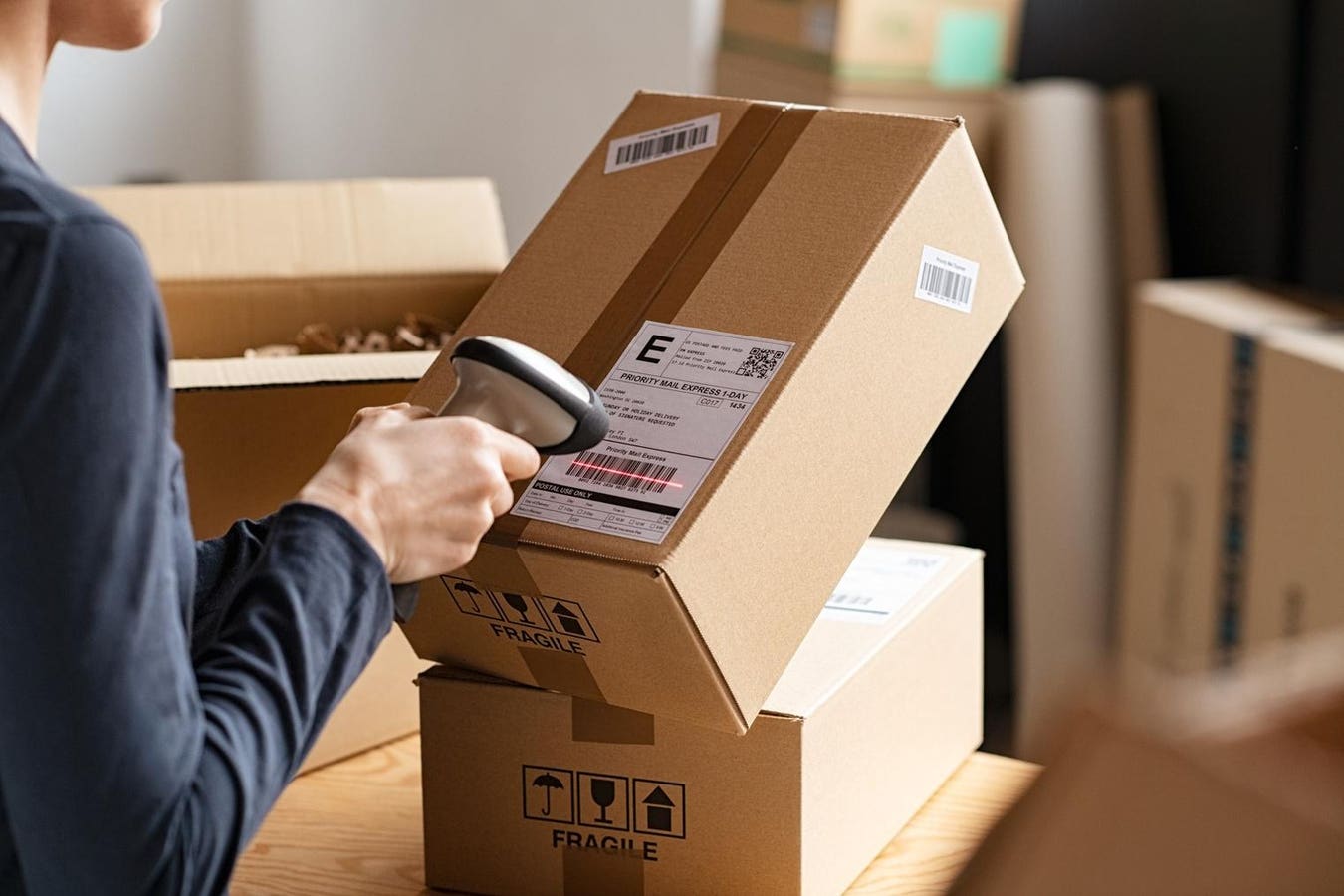
Shipping products to buyers both domestically and internationally is a lucrative way to expand your business income, but navigating shipping fees and regulations can be challenging. Below are several options for fast and affordable shipping solutions to satisfy your customers worldwide.
Hands of young woman scanning barcode on delivery parcel. Worker scan barcode of cardboard packages ... [+] before delivery at storage. Woman working in factory warehouse reading and scanning labels on the boxes with bluetooth barcode scanner.
1. Multi-Carrier Shipping Manager Software
Overpaying for shipping is a common mistake, as comparing rates between carriers is time-consuming and potentially confusing. Choosing the right shipping software can make a world of difference in quickly managing unshipped orders and calculating postage costs.
For example, many artists, resellers, and businesses rely on Rollo for all-in-one integration because the platform doesn’t require monthly fees or minimum volumes. Additionally, business owners can quickly print labels with competitive shipping discounts without having to buy proprietary labels or hardware to use the shipping software.
The free Rollo Ship platform, available for iOS, Android, and desktop, automatically integrates with the largest eCommerce websites, including Amazon, eBay, Magento, Poshmark, Shopify, and Walmart Marketplace. It also doesn’t require minimum volume requirements or a monthly fee.
Shipping software perks include:
- Discounted shipping rates: Rates up to 90% lower than the public retail rates for multiple couriers. It’s also easy to compare shipping discounts by cheapest, fastest, or premium service.
- Bulk shipping: Shipping software can group your orders across all selling channels by comparing rates and transit times. This convenience also saves plenty of time by automating administrative tasks.
- Shipping presets: For frequently sold items, you can easily compare the latest rates for specific product dimensions, package weight, and destination.
- Online store integration: Use a single platform to manage your orders and sync shipping across multiple eCommerce channels, including dropship transactions.
- Scheduled pickups: Coordinate with carriers to have them pick up your order directly from your home or business with a few button clicks. Further, track shipments and handle delays regardless of the carrier or selling platform.
- Inventory management: View real-time quantities, reserve inventory for unshipped orders, and receive low-stock or out-of-stock alerts.
- Hands-on support: Whether you ship a handful of items each month or hundreds per week, there will be instances when platform or shipping issues need to be resolved. A helpful customer support team can provide quick solutions.
In addition to the shipping benefits, the platform has a free label designer with over 500 templates. It’s beginner-friendly and can print from any device and printer using any label brand.
Moreover, using budget-friendly software doesn’t mean sacrificing customer service quality.
“One of the greatest joys is connecting with our customers and seeing the unique items they’re shipping. One moment it’s freshly baked cookies, the next it’s rare vintage industrial treasures,” says Stephanie Espolt, marketing manager at Rollo.
Espolt continues, “Every now and then, we get a call from a business owner who needs to ship their order today, before the shipping cut-off time, and their computer is acting up. To be able to jump in and either initiate or restore a smooth shipping process is deeply satisfying to our team. We have provided not just a printer but an ongoing experience. Now the customer has one less thing to worry about.”
2. Invest in a Thermal Label Printer
Sellers shipping their own inventory can also save time and money with a high-end thermal printer. Sellers can notably reduce packaging costs thanks to its budget-friendly startup costs and maintenance-free usage.
First, this eco-friendly technology doesn’t require ink or toner cartridges which can be expensive and a hassle to replace. Instead, the printhead imprints the shipping label using heat and can produce thousands of labels virtually maintenance-free.
For instance, AirPrint and Wi-Fi-friendly shipping label printers from Rollo cost less than $300 and are compatible with any operating system. USB thermal label printers are also available at a lower cost.
These printers can provide a frustration-free shipping experience in several ways:
- Easy setup and update: Set up within minutes and receive over-the-air updates
- Low maintenance: Ink-free printing and fewer moving parts than traditional printers reduce ongoing costs and upkeep
- Intelligent label detection: Auto-detect shipping label sizes across multiple online stores without the need for manual cropping.
- All-in-one shipping labels: Compatible with any brand or size, such as 4x6, 2x1, and 2 inches. Thermal printers can also handle barcode labels, round labels, and decorative labels.
Further, adhesive thermal shipping labels typically cost noticeably less than similar laser printer labels. Since thermal labels are adhesive, packaging tape costs are eliminated in addition to ink or toner.
Research studies indicate businesses are adopting this cost-cutting measure with a 5% annual growth rate per year. Specifically, the thermal printing industry is estimated to grow from $42.96 billion to $58.59 billion in 2030 as sellers shift away from resource-intensive ink printers.
Coupling shipping discounts with the ability to print shipping labels at a sharply lower cost are the most effective ways to boost profits and
High-volume shippers will reap the highest savings potential, although low-volume sellers can also benefit from the convenience.
Using Rollo label printing and shipping software.
3. Purchase Shipping Insurance
Shipping insurance plays an increasingly prominent role in minimizing potential losses from counterfeit, missing, stolen, and damaged products. Increased shipping volumes raise the likelihood of mishaps that erode a seller’s profit margins.
In fact, UPS Capital’s 2024 Mid-Year Guide to Shipping Excellence states that nearly 99% of merchants utilize insurance to minimize replacement costs.
In addition to carrier-provided coverage, sellers may consider buying a blanket policy from independent providers to cover multiple deliveries at a more affordable price than per-label insurance purchases.
Compare carrier and third-party policy costs for similar coverage limits. Price quotes can vary from 20% to 50% between providers. It’s also worth comparing claim filing windows and minimum waiting periods to receive reimbursement as soon as possible.
If it’s necessary to file a claim, remember that it’s worth contacting the customer support team of the shipping software used to produce the label. The agents can help sellers navigate the claims process.
4. Use Multiple Warehouses
Multi-warehousing inventory helps achieve ideal shipping speeds and costs. This e-commerce fulfillment strategy also reduces supply chain risk and can solidify sustainable business growth.
Once again, multi-partner shipping apps manage pending orders and can delegate dropshipping tasks to the nearest warehouse. The on-site staff prints shipping labels and packages the merchandise, requiring only the owner to handle administrative work.
Outsourcing shipping and logistics to a fourth-party logistics (4PL) or third-party logistics (3PL) provider eliminates communication barriers and ensures the availability of warehouse storage space and dedicated order fulfillment resources.
An excellent shipping indicator is that eMarketer projects global e-commerce revenues to grow by 7% year-over-year through 2030 as more households around the world rely on internet sellers to deliver the items they need.
The incrementally higher sales volumes can lead to more competitive rates. It can also require innovative solutions to accomplish customer satisfaction.
5. Hire a Customs Broker
Cross-border transactions increase the probability of shipping delays at ports of entry and congested shipping lanes. Certain types of merchandise are more susceptible to delays, tariffs, and legal issues.
While not every international seller benefits from this solution, hiring a customs broker can help smooth out these logistical headaches. The broker is your legal representative to help clear the customs process sooner, satisfy compliance audits, and work with local logistics providers to confirm timely delivery.
Custom brokers play an essential role in shipping high-value items, time-sensitive inventory, or products with confusing classification codes.
These experts can be more efficient at:
- Accurately calculating taxes and tariffs
- Proper product classifications using Harmonized Systems (HS) codes
- Researching regulations
- Understanding local customs and procedures
When comparing brokers, consider their certifications, regional expertise, and technology use. Many offer real-time communication with shippers for optimal transparency.
Final Thoughts
Choosing an all-in-one shipping and label printer platform can be the easiest way for the average shipper and current USPS, FedEx, and UPS clients to streamline their operations and trim overhead expenses. More advanced solutions become beneficial with high-value or time-sensitive shipments.
Related Articles:








